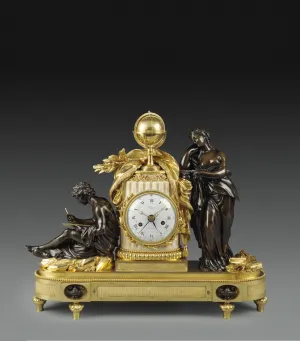Renacle-Nicolas Sotiau
Renacle-Nicolas Sotiau (1749–1791)
Figures after Simon-Louis Boizot (1743–1809)
Mantel Clock Representing Study and Philosophy
Paris, c. 1785–90
Patinated and gilt bronze, marbre, enameled metal, and glass
22 1/2 x 21 13/16 x 5 1/2 in. (57.2 x 53.8 x 14 cm)
Horace Wood Brock Collection
Although the pendulum clock was invented in 1653 by the Dutch mathematician Christiaan Huygens (1629–1695), its development took place in England and France. This scientific revolution transformed clocks into precise timekeepers that were both decorative and functional. Around 1669 a special type of escapement was invented that enabled pendulum clocks to keep time within a few seconds. While the British designed the case around the movement, the French gave increasing importance to the case. The French eighteenth-century clocks featured in this exhibition are all pendulum clocks, including this example with figures in bronze representing Study and Philosophy after a sculpture by Simon-Louis Boizot. The movement is by the renowned clockmaker Renacle-Nicolas Sotiau, who supplied timepieces to Louis XVI, Marie-Antoinette, and the daughters of Louis XV, among others.

